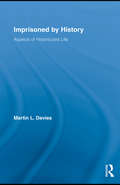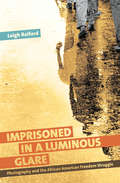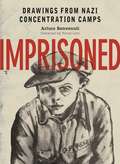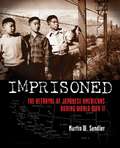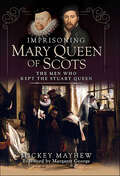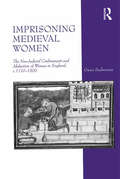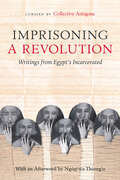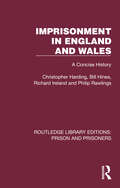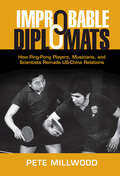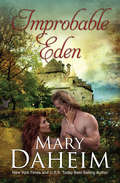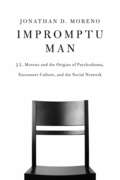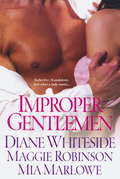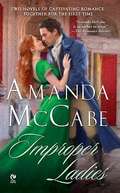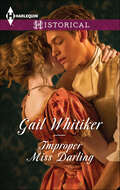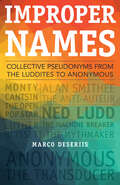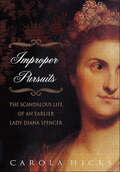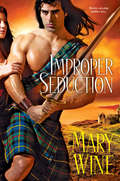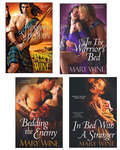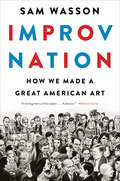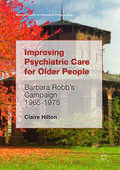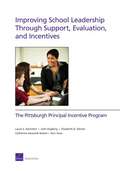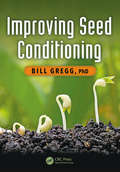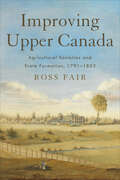- Table View
- List View
Imprisoned by History: Aspects of Historicized Life (Routledge Approaches to History)
by Martin L. DaviesImprisoned by History: Aspects of Historicized Life offers a controversial analysis, grounded both in philosophical argument and empirical evidence, of what history does in contemporary culture. It endorses and extends the argument that contemporary society is, in historical terms, already historicized, shaped by history – and thus history loses sight of the world, seeing it only as a reflection of its own self-image. By focusing on history as a way of thinking about the world, as a thought-style, this volume delivers a major, decisive, thought-provoking critique of a crucial aspect contemporary culture and the public sphere. By illustrating the ways in which history enforces socially coercive attitudes and forms of behaviour, Martin Davies argues that history is therefore in itself ideological and exists as an instrument of political power. Contending that this ideological function is the "normal" function of professional academic history, he repudiates entirely the conventional view that only biased or "bad" history is ideological. By finding history projecting onto the world and getting reflected back at it the exacting, history-focused thinking and behaviour on which the discipline and the subject rely, he concludes that history’s very "normality" and "objectivity" are inherently compromised and that history works only in terms of its own self-interest.
Imprisoned in a Luminous Glare: Photography and the African American Freedom Struggle
by Leigh RaifordLeigh Raiford argues that over the past one hundred years activists in the black freedom struggle have used photographic imagery both to gain political recognition and to develop a different visual vocabulary about black lives. Raiford analyzes why activists chose photography over other media, explores the doubts some individuals had about the strategies, and shows how photography became an increasingly effective, if complex, tool in representing black political interests. Offering readings of the use of photography in the anti-lynching movement, the civil rights movement, and the black power movement, Raiford focuses on key transformations in technology, society, and politics to understand the evolution of photography's deployment in capturing white oppression, black resistance, and African American life. By putting photography at the center of the long African American freedom struggle, Raiford also explores how the recirculation of these indelible images in political campaigns and art exhibits both adds to and complicates our memory of the events.
Imprisoned: Drawings from Nazi Concentration Camps
by Primo Levi Arturo BenvenutiIn September 1979, at age fifty-six, writer and artist Arturo Benvenuti fueled up his motor home and set forth on what he knew would be an emotional journey. His plan-his own Viae Crucis-was to meet with as many former prisoners of Nazi-fascist concentration camps as he could. He wanted not only to learn their stories, but to learn from their stories.He met with dozens of survivors from Auschwitz, Terezín, Mauthausen-Gusen, Buchenwald, Dachau, Gonars, Monigo, Renicci, Banjica, Ravensbrück, Jasenovac, Belsen, and Gurs. Many of these men and women shared their memories with Benvenuti along with artwork they’d created during their internment with pencil, ink, and charcoal.After four decades of research, Benvenuti presented these original black-and-white pieces in Imprisoned. This stunning collection provides visuals that oftentimes even the most eloquent words and sentences cannot convey.In his foreword, chemist, writer, and Holocaust survivor Primo Levi highlighted the importance of these reproductions, stating, "some have the immediate power of art; all have the raw power of the eye that has seen and that transmits its indignation.”
Imprisoned: The Betrayal of Japanese Americans During WWII
by Martin W. SandlerWhile Americans fought for freedom and democracy abroad, fear and suspicion towards Japanese Americans swept the country after Japan's sneak attack on Pearl Harbor. The author presents an in-depth account of the Japanese Americans' lives before, during their imprisonment, and after their release.
Imprisoning Mary Queen of Scots: The Men Who Kept the Stuart Queen
by Mickey MayhewImprisoning Mary Queen of Scots covers the lives and careers of the men and women who ‘kept’ Mary Queen of Scots when she was a political prisoner in England, circa 1568/9-1587. Mary’s troubled claim to the English throne - much to the consternation of her ‘dear cousin’ Elizabeth I - made her a mortal enemy of the aforementioned Virgin Queen and set them on a collision course from which only one would walk away. Mary’s calamitous personal life, encompassing assassinations, kidnaps and abdications, sent her careering into England and right into the lap of Henry VIII’s shrewd but insecure daughter. Having no choice but keep Mary under lock and key, Elizabeth trusted this onerous task to some of the most capable - not to mention the richest - men and women in England; Sir Francis Knollys, Rafe Sadler (of Wolf Hall fame), the Earl of Shrewsbury and his wife, Bess of Hardwick, and finally, the puritanical nit-picker Sir Amyas Paulet. Until now, these nobles have been mere bit-players in Mary’s story; now, their own lives, loves and fortunes are laid bare for all to see. From Carlisle Castle to Fotheringay, these men and women all but bankrupted themselves in keeping the deposed Scots queen in the style to which she was accustomed, while fending off countless escape plots of which Mary herself was often the author. With the sort of twist that history excels at, it was in fact a honeytrap escape plot set up by Elizabeth’s ministers that finally saw Mary brought to the executioner’s block, but what of the lives of the gaolers who had until then acted as her guardian? This book explains how Shrewsbury and Bess saw their marriage wrecked by Mary’s legendary charms, and how Sir Amyas Paulet ended up making a guest appearance on ‘Most Haunted’, some several hundred years after his death. In that theme, the book also covers the appearances of these men and women on film and TV, in novels and also the various other Mary-related media that help keep simmering the legend of this most misunderstood of monarchs.
Imprisoning Medieval Women: The Non-Judicial Confinement and Abduction of Women in England, c.1170-1509
by Gwen SeabourneThe non-judicial confinement of women is a common event in medieval European literature and hagiography. The literary image of the imprisoned woman, usually a noblewoman, has carried through into the quasi-medieval world of the fairy and folk tale, in which the 'maiden in the tower' is one of the archetypes. Yet the confinement of women outside of the judicial system was not simply a fiction in the medieval period. Men too were imprisoned without trial and sometimes on mere suspicion of an offence, yet evidence suggests that there were important differences in the circumstances under which men and women were incarcerated, and in their roles in relation to non-judicial captivity. This study of the confinement of women highlights the disparity in regulation concerning male and female imprisonment in the middle ages, and gives a useful perspective on the nature of medieval law, its scope and limitations, and its interaction with royal power and prerogative. Looking at England from 1170 to 1509, the book discusses: the situations in which women might be imprisoned without formal accusation of trial; how social status, national allegiance and stage of life affected the chances of imprisonment; the relevant legal rules and norms; the extent to which legal and constitutional developments in medieval England affected women's amenability to confinement; what can be known of the experiences of women so incarcerated; and how women were involved in situations of non-judicial imprisonment, aside from themselves being prisoners.
Imprisoning a Revolution: Writings from Egypt's Incarcerated
by Collective AntigoneA groundbreaking collection of writings by political prisoners in Egypt, offering a unique lens on the global rise of authoritarianism during the last decade. This book contains letters, poetry, and art produced by Egypt's incarcerated from the eruption of the January 25, 2011, uprising. Some are by journalists, lawyers, activists, and artists imprisoned for expressing their opposition to Egypt's authoritarian order; others are by ordinary citizens caught up in the zeal to silence any hint of challenge to state power, including bystanders whose only crime was to be near a police sweep. Together, the contributors raise profound questions about the nature of politics in both authoritarian regimes and their "democratic" allies, who continue to enable and support such violence. This collection offers few answers and even less consolation, but it does offer voices from behind the prison walls that remind readers of our collective obligation not to look away or remain silent. With a foreword by acclaimed Egyptian novelist Ahmed Naji and an afterword with Kenyan literary giant Ngũgĩ wa Thiong'o, Imprisoning a Revolution holds a mirror not just to Egypt but to the world today, urging us to stop the rampant abuse and denial of fundamental human rights around the globe.
Imprisonment in England and Wales: A Concise History (Routledge Library Editions: Prison and Prisoners)
by Richard Ireland Philip Rawlings Christopher Harding Bill HinesOriginally published in 1985, Imprisonment in England and Wales is an account of the changing functions and conditions of imprisonment in England and Wales from the Medieval period to the present day. It is designed both as a text for students and teachers of history, law and social science and as an introduction to the subject for more general readers and is one of the few attempts to provide an overall view of the institution of imprisonment in this country over a period of several centuries. The authors have made use of original sources and other research to provide an accessible account of the subject, combining essential factual detail with an analysis of the use of imprisonment. It is therefore particularly of interest to those approaching the subject for the first time and is also intended to provide guidance for further research into particular areas of the subject. The authors draw upon their respective knowledge of four main periods to show how imprisonment has performed a number of different functions: the punishment and reform of convicted offenders, the coercion of debtors, the custody of persons awaiting trial and more generally the containment of society’s undesirables. At the same time, the institution of imprisonment is put into the context of wider social, political and economic forces, and related to the development of an increasingly centralised and incursive system of criminal law, as well as to the use and disuse of other forms of punishment and legal control. This discussion is supported by an account of the characteristics of prisons, the problems of administration and the implementation of penal and reformative policy.
Improbable Diplomats: How Ping-Pong Players, Musicians, and Scientists Remade US-China Relations (Cambridge Studies in US Foreign Relations)
by Pete MillwoodIn 1971, Americans made two historic visits to China that would transform relations between the two countries. One was by US official Henry Kissinger; the other, earlier, visit was by the US table tennis team. Historians have mulled over the transcripts of Kissinger's negotiations with Chinese leaders. However, they have overlooked how, alongside these diplomatic talks, a rich program of travel and exchange had begun with ping-pong diplomacy. Improbable Diplomats reveals how a diverse cast of Chinese and Americans – athletes and physicists, performing artists and seismologists – played a critical, but to date overlooked, role in remaking US-China relations. Based on new sources from more than a dozen archives in China and the United States, Pete Millwood argues that the significance of cultural and scientific exchanges went beyond reacquainting the Chinese and American people after two decades of minimal contact; exchanges also powerfully influenced Sino-American diplomatic relations and helped transform post-Mao China.
Improbable Eden
by Mary DaheimThe base-born daughter of an earl and a courtesan, nineteen-year-old Eden is torn from her foster family, whisked off to London, and groomed to follow in her mother’s footsteps. Her lessons in court etiquette are overseen by the striking Flemish prince Maximilian, who has fallen on hard times. But those times get even harder when both Max and Eden’s father are branded as Jacobites intent on killing His Highness, William of Orange. Now Eden is their last hope. If she can seduce the King, she can use her influence to clear Max’s name and free her father from the Tower of London. But beneath her courtesan’s smile lies a true heart. And Eden cannot deny her growing love for Max, whose very life now depends on giving herself to another . . .
Impromptu Man
by Jonathan D. Moreno"Impromptu Man captures the remarkable impact of a singular genius, J.L. Moreno, whose creations-the best-known being psychodrama-have shaped our culture in myriad ways, many unrecognized. The record will be set straight for all time by this can't-put-down biography, a tribute by Jonathan D. Moreno to his father's masterly legacy." -DANIEL GOLEMAN, author of Emotional Intelligence: Why It Can Matter More Than IQJ.L. Moreno (1889-1974), the father of psychodrama, was an early critic of Sigmund Freud, wrote landmark works of Viennese expressionism, founded an experimental theater where he discovered Peter Lorre, influenced Martin Buber, and became one of the most important psychiatrists and social scientists of his time. ??A mystic, theater impresario and inventor in his youth, Moreno immigrated to America in 1926, where he trained famous actors, introduced group therapy, and was a forerunner of humanistic psychology. As a social reformer, he reorganized schools and prisons, and designed New Deal planned communities for workers and farmers. Moreno's methods have been adopted by improvisational theater groups, military organizations, educators, business leaders, and trial lawyers. His studies of social networks laid the groundwork for social media like Twitter and Facebook. ??Featuring interviews with Clay Shirky, Gloria Steinem, and Werner Erhard, among others, original documentary research, and the author's own perspective growing up as the son of an innovative genius, Impromptu Man is both the study of a great and largely unsung figure of the last century and an epic history, taking readers from the creative chaos of early twentieth-century Vienna to the wired world of Silicon Valley.Jonathan D. Moreno, called the "most interesting bioethicist of our time" by the American Journal of Bioethics, is a professor at the University of Pennsylvania and a Senior Fellow at the Center for American Progress.
Improper Gentlemen
by Mia Marlowe Diane WhitesideUnsuitable. Forbidden. Oh-so-seductive. These gentlemen are hardly respectable. But they are the very, very best...Talbot's Ace Diane Whiteside"...Prose so steamy that it fogs one's reading glasses."-BooklistHe rules Colorado's most glittering, anything-goes gambling palace. And Justin Talbot never does something for nothing. But if daring Boston aristocrat Charlotte Morland needs his protection from a dangerous enemy, he'll have no choice but to make her business his pleasure...To Match a Thief Maggie Robinson"A fun read that will keep you turning pages in the night."-Affaire de Coeur on Mistress by MistakeEx-pickpocket Sir Simon Keith can finally afford the best of everything. But London's most-desired courtesan is his lost love Lucy. Now Simon will need his wits and his considerably large...wiles to win his way back into her bed-and into her heart. A Knack for Trouble Mia Marlowe"Mia Marlowe is a rising star!"-Connie MasonLord Aidan Stonemere didn't go from prison to a title playing by society's rules. If he wants something, he takes it, and Rosalinde Burke didn't object to being taken. Once. To keep her from marrying a staid viscount, Aidan's about to remind her how deliciously good being bad feels...
Improper Ladies
by Amanda MccabeTwo classic regencies together for the first time The Golden Feather Young Caroline Aldritch is shocked to learn her late husband's only legacy to her is a notorious gaming establishment-where she must hide her face from all, including the dashing Lord Lyndon, who's determined to unmask the secretive beauty. . . The Rules of Love Rosalind Chase must endure her brother's friendship with the notorious rake Lord Morley. But when she can't stop thinking of the insufferable libertine, Rosalind wonders if his ways just might be the path to love. . . .
Improper Miss Darling
by Gail WhitikerA HIGHLY UNSUITABLE MATCHWhen Alexander, Viscount Stewart, arrives on Emma Darling’s doorstep, protesting his brother’s engagement to her younger sister, she’s furious! Emma cares not a jot that Alex is the heir to an earldom and she’s a society unknown-how dares this high-handed gentleman meddle in her family’s private affairs? Buoyed up by anger, the last thing independent Emma needs is the realisation that she’s developed an extremely inappropriate tendre for Alex himself. For if their younger siblings’ match is considered unsuitable, a relationship between them is well nigh unthinkable...
Improper Names: Collective Pseudonyms from the Luddites to Anonymous (A Quadrant Book)
by Marco DeseriisImproper Names offers a genealogy and theory of the &“improper name,&” which author Marco Deseriis defines as the adoption of the same pseudonym by organized collectives, affinity groups, and individual authors. Although such names are often invented to pursue a specific social or political agenda, they are soon appropriated for different and sometimes diverging purposes. This book examines the tension arising from struggles for control of a pseudonym&’s symbolic power.Deseriis provides five fascinating and widely varying case studies. Ned Ludd was the legendary and eponymous leader of the English Luddites, textile workers who threatened the destruction of industrial machinery and then advanced a variety of economic and political demands. Alan Smithee—an alias coined by Hollywood film directors in 1969 in order to disown films that were recut by producers—became a contested signature and was therefore no longer effective to signal prevarication to Hollywood insiders. Monty Cantsin was an &“open pop star&” created by U.S. and Canadian artists in the late 1970s to critique bourgeois notions of authorship, but its communal character was compromised by excessive identification with individual users of the name. The Italian media activists calling themselves Luther Blissett, aware of the Cantsin experience, implemented measures to prevent individuals from assuming the alias, which was used to author media pranks, sell apocryphal manuscripts to publishers, fabricate artists and artworks, and author best-selling novels. The longest chapter here is devoted to the contemporary &“hacktivist&” group known as Anonymous, which protests censorship and restricted access to information and information technologies.After delving into a rich philosophical debate on community among those who have nothing in common, the book concludes with a reflection on how the politics of improper names affects present-day anticapitalist social movements such as Occupy and 15-M.
Improper Pursuits: The Scandalous Life of an Earlier Lady Diana Spencer
by Carola HicksWith these words to Boswell, Samuel Johnson dismissed Lady Di Beauclerk, the wife of one of his closest friends, a woman of the highest rank, the daughter of a duke, who had forsaken her reputation, her place in society, her children, and her role as lady-in-waiting to the Queen for love.Born Lady Diana Spencer in 1735, the eldest child of the third Duke of Marlborough, she was expected rigidly to follow a traditional path through life: educated in the fashion considered suitable for a girl, and married to a man of the appropriate rank for a duke's daughter. But finding herself in a desperately unhappy marriage to Viscount Bolingbroke, Lady Di overturned convention. She left her husband, maintained a secret relationship with her lover, Topham Beauclerk, hid the birth of an illegitimate child, and eventually helped to support herself by painting.Lady Di Beauclerk was a highly gifted artist who was able to use her scandalous reputation as an adulteress, aristocratic woman to further her career as a painter and designer. She painted portraits, illustrated plays and books, provided designs for Wedgwood's innovative pottery, and decorated rooms with murals. Championed by her close friend Horace Walpole, whose letters illuminate all aspects of her life, she was able to establish herself as an admired artist at a time when women struggled to forge careers.Carola Hicks provides an enthralling account of eighteenth-century society, in which Lady Di encountered many of the most eminent artistic, literary, and political figures of the day. Improper Pursuits is an absorbing study of a singular life.
Improper Seduction (Tudor Series #1)
by Mary WineA Rearranged Marriage Lord Curan Ramsden is home from war, and eager to claim his betrothed. And he arrives just in time--his bride's father has summoned her to London, to wed another man. But Bridget's father promised her to Curan, and Curan means to have her. Especially now that he sees the luscious young woman she has blossomed into. He'll just have to convince Bridget, somehow, that her heart is more important than her duty. . . Bridget Newbury has always done her duty--to her parents, to the church, to the man they selected as her betrothed. She knows what could happen if she disobeys her father. The king has put nobler women to death for lesser trespasses. But she was promised to Curan first, and his kisses are very tempting. . .
Improper Seduction Bundle with In the Warrior's Bed, Bedding the Enemy, & In Bed with A Stranger
by Mary WineImproper Seduction BundleImproper SeductionA Rearranged MarriageLord Curan Ramsden is home from war, and eager to claim his betrothed. And he arrives just in time--his bride's father has summoned her to London, to wed another man. But Bridget's father promised her to Curan, and Curan means to have her. Especially now that he sees the luscious young woman she has blossomed into. He'll just have to convince Bridget, somehow, that her heart is more important than her duty. . . Bridget Newbury has always done her duty--to her parents, to the church, to the man they selected as her betrothed. She knows what could happen if she disobeys her father. The king has put nobler women to death for lesser trespasses. But she was promised to Curan first, and his kisses are very tempting. . . Praise for the Novels of Mary Wine". . .delightful characters and a charming romance. . .definitely a must-read." --Heather Graham on >In Bed with a Stranger "A bold and lusty hero, a brave heroine, and intrigue at the royal court of Scotland. . .sexy and exciting as the Highland hills themselves!" --Elizabeth Hoyt on In the Warrior's BedIn the Warrior's BedIn this irresistible follow-up to her captivating debut, In Bed With a Stranger, Mary Wine revisits the McJames clan--their loves, their battles, their conquests. . . Cullen McJames will not have his honor sullied, certainly not by his clan's nemesis Laird Erik McQuade. So when McQuade tells the Court of Scotland that Cullen has stolen his daughter's virtue, Cullen steals the daughter instead. Since his brother wed a fetching lass, Cullen's been thinking he too needs a wife. A marriage could end the constant war between the clans. And looking on Bronwyn McQuade but once has put her in his dreams for a week. . . But Bronwyn won't go quietly. She won't be punished for what she did not do. Nor is she eager to live among the resentful veterans of McQuade wars. And however brave and beautiful a man Cullen may be, he has much to learn about a woman's fighting spirit. But as Bronwyn will discover, he has much to teach her as well. . .Bedding the EnemyLaird Keir McQuade is a newcomer to his title, and has much work before him to restore the McQuade honor. Finding a wife is an excellent start. He's duty-bound to go to court and swear homage to his king anyway, a perfect opportunity--were not court women trussed in stupid fashions and corrupted with false mannerisms. Of course, not every lady hides behind a powdered face... Helena Knyvett may be a daughter of the aristocracy, but in truth she is little but a pawn in her brother's ploys for power. Her smallest acts of defiance carry a heavy price. But one honorable man among a crowd of dandies could give her all she needs to change her fortunes--and set her free. . . Among the ruthless ambitions of England's powerful, love at first sight is a dangerous game. But the treachery, scandal, and treason that follow can unleash as much passion as it does adventure. . . "Sweeps you into the time period without taking a thing away from delightful characters and a charming romance. . .definitely a must-read." --Heather Graham on In Bed with a StrangerIn Bed with A StrangerAn Imperfect MatchBrodick McJames is an earl in name only. To secure his clan's future he needs an English wife. Mary Stanford, daughter of the Earl of Warwickshire, will suit perfectly. He's never met her, but what matter? She'll grace his bed eventually, and once she bears his child he need see her no more. Anne Copper looks just like her noble half-sister, but she was born illegitimate, and can never forget it. The best she can hope for is to stay a serving girl in her own father's house. But when Lady Mary finds herself betrothed to a Scot, it seems there's a use for Anne after all . . .The woman who arrives in Alcaon is not what Brodick expects, and the passion that grows between them promises far more than a marriage of convenience. When fate draws two together, it may take more than a noblewoman's plot to part them . . .
Improv Nation: How We Made a Great American Art
by Sam WassonA finalist for the 2017 George Freedley Memorial Award &“A compelling, absolutely unputdownable story . . . And, in case you&’re wondering, yes, the book is funny. In places, very funny. A remarkable story, magnificently told.&” — Booklist In this richly reported, scene-driven narrative, Sam Wasson charts the meteoric rise of improv from its unlikely beginnings in McCarthy-era Chicago. We witness the chance meeting between Mike Nichols and Elaine May, hang out at the after-hours bar where Dan Aykroyd hosted friends like John Belushi, Bill Murray, and Gilda Radner, and go behind the scenes of cultural landmarks from The Graduate to The Colbert Report. Along the way, we befriend pioneers such as Harold Ramis, Chevy Chase, Steve Carell, Amy Poehler, Alan Arkin, Tina Fey, Judd Apatow, and many others. Wasson shows why improv deserves to be considered the great American art form of the last half century. &“One of the most important stories in American popular culture . . . Wasson may be the first author to explain [improv&’s] entire history . . . For that reason alone, it&’s a valuable book.&” — New York Times Book Review &“A compelling history . . . It holds the element of surprise—true to the spirit of its subject.&” — Entertainment Weekly
Improving Psychiatric Care for Older People
by Claire HiltonThis book is open access under a CC BY 4. 0 license. This book tells the story of Barbara Robb and her pressure group, Aid for the Elderly in Government Institutions (AEGIS). In 1965, Barbara visited 73-year-old Amy Gibbs in a dilapidated and overcrowded National Health Service psychiatric hospital back-ward. She was so appalled by the low standards that she set out to make improvements. Barbara's book Sans Everything: A case to answer was publicly discredited by a complacent and self-righteous Ministry of Health. However, inspired by her work, staff in other hospitals 'whistle-blew' about events they witnessed, which corroborated her allegations. Barbara influenced government policy, to improve psychiatric care and health service complaints procedures, and to establish a hospitals' inspectorate and ombudsman. The book will appeal to campaigners, health and social care staff and others working with older people, and those with an interest in policy development in England, the 1960s, women's history and the history of psychiatry and nursing.
Improving School Leadership Through Support, Evaluation, and Incentives: The Pittsburgh Principal Incentive Program
by Laura S. Hamilton Kun Yuan John Engberg Elizabeth D. Steiner Catherine Awsumb NelsonThis report examines Pittsburgh Public Schools' implementation and outcomes of the Pittsburgh Principal Incentive Program from school years 2007-2008 through 2010-2011, how principals and other school staff have responded to the reforms, and what outcomes accompanied program implementation.
Improving Seed Conditioning
by Bill GreggSeed conditioning is the final process that establishes the quality of a seed lot and determines its value. It is a complex process involving a significant series of machines, each of which must be used in the proper sequence of the entire process, and each machine must be carefully and properly adjusted and set up for each lot of seed. If the conditioning plant operator does not have sufficient knowledge of how to set up and adjust each of the machines, then an excessive amount of good seed is lost during conditioning and not all undesirable materials are removed. Therefore, the performance of seed conditioning depends entirely on how effectively the operator sets up and adjusts the machines. Much effort has been spent in developing seed technology so as to produce high quality seed, but performance of seed conditioning by maximizing the operator’s knowledge of getting the best performance from each of his machines has not been carefully and completely developed. Improving Seed Conditioning focuses on teaching the conditioning plant operator details of each machine and how to get maximum performance from it in terms of operating efficiency, maximum removal of undesirable particles, and minimum loss of good seed. Organized in a manner that focuses on the specific machine models installed in each operator’s specific plant, this manual is set up to be used as text material in training classes or as a guide for operators employed by seed companies.
Improving The Presumptive Disability Decision-making Process For Veterans
by Institute of Medicine of the National AcademiesProduced by a committee of the Institute of Medicine, this report describes the current decision-making process for the provision of appropriate health care and disability compensation for veterans with health conditions that develop after military service which, in the absence of scientific evidence to create a complete link, are presumed to be connected to their military service. The report contains a brief history of presumptive disability decisions, description of the decision-making process, legislative background on presumptions, and evaluations of selected case studies of specific exposures and illnesses, and proposes a revised framework for building stronger scientific evidence into the process for making presumptive decisions in the future. The 13 appendices contain information organized by the Committee and Institute of Medicine to assist readers in understanding the background and issues; three of the appendices are in the book and ten are on an accompanying CD-ROM. No subject index. Annotation ©2009 Book News, Inc. , Portland, OR (booknews. com)
Improving Upper Canada: Agricultural Societies and State Formation, 1791–1852
by Ross FairAgricultural societies founded in the colony of Upper Canada were the institutional embodiment of the ideology of improvement, modelled on contemporary societies in Britain and the United States. In Improving Upper Canada, Ross Fair explores how the agricultural improvers who established and led these organizations were important agents of state formation. The book investigates the initial failed attempts to create a single agricultural society for Upper Canada. It examines the 1830 legislation that publicly funded the creation of agricultural societies across the colony to be semi-public agents of agricultural improvement, and analyses societies established in the Niagara, Home, and Midland Districts to understand how each attempted to introduce specific improvements to local farming practices. The book reveals how Upper Canada’s agricultural improvers formed a provincial association in the 1840s to ensure that the colonial government assumed a greater leadership role in agricultural improvement, resulting in the Bureau of Agriculture, forerunner of federal and provincial departments of agriculture in the post-Confederation era. In analysing an early example of state formation, Improving Upper Canada provides a comprehensive history of the foundations of Ontario’s agricultural societies today, which continue to promote agricultural improvement across the province.
Improving the Air Force Scientific Discovery Mission: A Workshop Report
by Committee on Improving the Air Force Scientific Discovery Mission: Leveraging Best Practices in Basic Research Management: A WorkshopIn 2015, the Air Force Studies Board conducted a workshop, consisting of two data-gathering sessions, to review current research practices employed by the Air Force Office of Scientific Research (AFOSR). Improving the Air Force Scientific Discovery Mission summarizes the presentations and discussions of these two sessions. This report explores the unique drivers associated with management of a 6. 1 basic research portfolio in the Department of Defense and investigates current and future practices that may further the effective and efficient management of basic research on behalf of the Air Force
